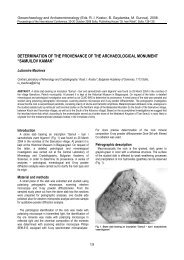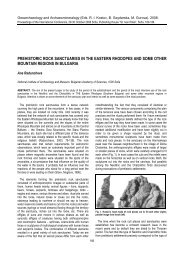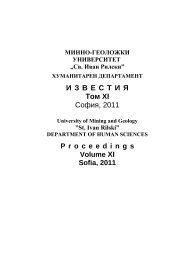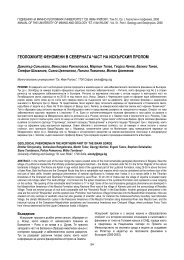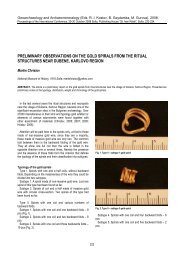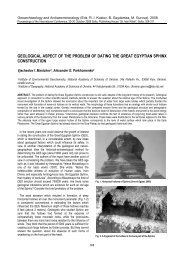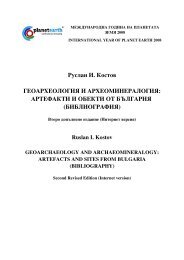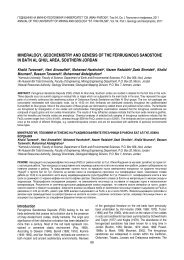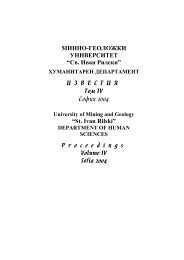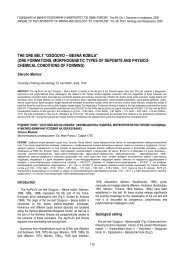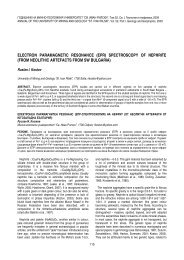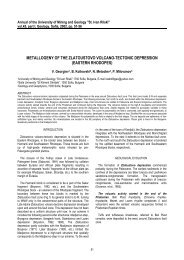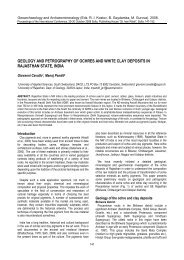archaeological evidence for the exploitation of gold ore deposits at ...
archaeological evidence for the exploitation of gold ore deposits at ...
archaeological evidence for the exploitation of gold ore deposits at ...
Create successful ePaper yourself
Turn your PDF publications into a flip-book with our unique Google optimized e-Paper software.
<strong>the</strong> period <strong>of</strong> <strong>the</strong> last years from <strong>the</strong> IV c. BC to <strong>the</strong> second<br />
decade <strong>of</strong> <strong>the</strong> III c. BC (Tonkova, 2002). Without direct<br />
connection with <strong>the</strong> <strong>the</strong>me under consider<strong>at</strong>ion, this find is a<br />
circuitous argument <strong>for</strong> <strong>the</strong> level <strong>of</strong> living, political organiz<strong>at</strong>ion,<br />
commercial and cultural rel<strong>at</strong>ions <strong>of</strong> a settlement and also<br />
illustr<strong>at</strong>es <strong>the</strong> prosperity <strong>of</strong> <strong>the</strong> region connected with <strong>the</strong> mine<br />
<strong>exploit<strong>at</strong>ion</strong> also in <strong>the</strong> Early Hellenistic period.<br />
Thracian sanctuary near <strong>the</strong> village <strong>of</strong> Babyak<br />
and <strong>the</strong> <strong>ore</strong> mining deposit “Babyak”, Western<br />
Rhodopes<br />
The loc<strong>at</strong>ion and unique <strong>archaeological</strong> finds from <strong>the</strong><br />
sanctuary near <strong>the</strong> village <strong>of</strong> Babyak present us with <strong>the</strong><br />
opportunity to describe it as a fundamental cult place <strong>of</strong> <strong>the</strong><br />
belligerent Bessoi – <strong>the</strong> Thracian popul<strong>at</strong>ion th<strong>at</strong> origin<strong>at</strong>ed<br />
from <strong>the</strong> Western Rhodopes area and <strong>the</strong> valleys along <strong>the</strong><br />
Upper Mesta River (Domaradski et al., 1999; Gotzev, 1994;<br />
Tonkova, 2005; 2007; Tonkova, Gotzev, Ed., 2008).<br />
The sanctuary near Babyak is situ<strong>at</strong>ed over a threesectioned<br />
peak “Babyashka Chuka” loc<strong>at</strong>ed on a high summit<br />
(1653.6 m a.s.l.), а n<strong>at</strong>ural dominant over <strong>the</strong> surroundings, <strong>the</strong><br />
view it reveals encompasses <strong>the</strong> valley <strong>of</strong> Razlog, Predela,<br />
Pirin, Rila, and <strong>the</strong> spectacular landscape <strong>of</strong> <strong>the</strong> Rhodopes.<br />
The remains <strong>of</strong> <strong>the</strong> cult activities th<strong>at</strong> had taken place <strong>the</strong>re<br />
have <strong>for</strong>med cultural layers thick up to 3 meters in some<br />
places. Abundant with <strong>archaeological</strong> m<strong>at</strong>erials, this area<br />
covers over 6-7 decares. The str<strong>at</strong>igraphic examin<strong>at</strong>ions<br />
showed th<strong>at</strong> <strong>the</strong> sanctuary had been in <strong>exploit<strong>at</strong>ion</strong> <strong>for</strong> m<strong>ore</strong><br />
than 14 centuries in <strong>the</strong> period between I mill. BC – V c. AD. It<br />
existed during four chronological periods – L<strong>at</strong>e Bronze, Early<br />
Iron, L<strong>at</strong>e Iron and Roman Age.<br />
The first ascertained period <strong>of</strong> zenith <strong>for</strong> <strong>the</strong> sanctuary is<br />
assigned to <strong>the</strong> second half <strong>of</strong> <strong>the</strong> Early Iron Age (VIII-VI c.<br />
BC). To th<strong>at</strong> period can be assigned <strong>the</strong> earliest <strong>for</strong>tific<strong>at</strong>ion<br />
walls. O<strong>the</strong>r represent<strong>at</strong>ives <strong>of</strong> <strong>the</strong> period are also <strong>the</strong> first<br />
structures rel<strong>at</strong>ed to <strong>the</strong> <strong>of</strong>fering <strong>of</strong> gifts: clay altars different in<br />
size and shape, stone heaps and ritual pits. The gifts represent<br />
mostly fragments <strong>of</strong> pottery with characteristic <strong>of</strong> this period<br />
ornaments.<br />
The second period <strong>of</strong> existence <strong>for</strong> <strong>the</strong> sanctuary refers to<br />
<strong>the</strong> L<strong>at</strong>e Iron Age (V-I c. BC). Particularly distinctive is <strong>the</strong><br />
growth <strong>of</strong> <strong>the</strong> sanctuary between <strong>the</strong> end <strong>of</strong> <strong>the</strong> III c. BC until I<br />
c. BC. In this period <strong>the</strong> cult area (temenos) is enclosed by<br />
light stone wall (peribol). The cult practices during th<strong>at</strong> period<br />
are organized around altars and in gift depots, representing<br />
clay altars with different shape, ritual pits, stone heaps in lines,<br />
altern<strong>at</strong>ing pl<strong>at</strong><strong>for</strong>ms and clefts, rock niches filled with gifts and<br />
“sealed” with arranged little stones. The sanctuary flourished<br />
also during <strong>the</strong> Roman Period. The most significant traces <strong>of</strong><br />
this time are expl<strong>ore</strong>d in <strong>the</strong> High Pinnacle. There were found<br />
roughly processed stone column and ceramic building m<strong>at</strong>erial<br />
which presumes <strong>the</strong> presence <strong>of</strong> a temple d<strong>at</strong>ing from th<strong>at</strong><br />
period. In th<strong>at</strong> sector are found fragments <strong>of</strong> a monumental<br />
marble st<strong>at</strong>ue <strong>of</strong> a Thracian goddess <strong>of</strong> fertility, as well as<br />
votive tablets <strong>of</strong> Hera and Zeus. The various gifts <strong>of</strong> metal and<br />
clay also certify <strong>for</strong> diverse manifest<strong>at</strong>ions <strong>of</strong> <strong>the</strong> cult from th<strong>at</strong><br />
time. The large amount <strong>of</strong> silver and bronze coins (over 200)<br />
found in <strong>the</strong> sanctuary refers mostly to <strong>the</strong> L<strong>at</strong>e Roman Age<br />
and L<strong>at</strong>e Antiquity.<br />
269<br />
There have been clarified some very important aspects <strong>of</strong> <strong>the</strong><br />
cult – chthonic and also <strong>the</strong> solar aspects. In <strong>the</strong> time <strong>of</strong><br />
ancient Thrace <strong>the</strong>se comprehensive powers are possessed<br />
by <strong>the</strong> highest Thracian deity – <strong>the</strong> Gre<strong>at</strong> Thracian Goddess.<br />
Along with Her most probably a male deity had been<br />
worshipped as well, if we are to judge by <strong>the</strong> presented as gifts<br />
mining tools and weapons. During <strong>the</strong> Roman Age those gods<br />
were personified as Hera and Zeus, according to <strong>the</strong> votive<br />
tablets found here.<br />
Among <strong>the</strong> gifts <strong>for</strong> <strong>the</strong> gods <strong>of</strong>fered <strong>at</strong> <strong>the</strong> sanctuary most<br />
common are fragments <strong>of</strong> pottery and means <strong>of</strong> labor (large<br />
amount <strong>of</strong> loom weights and spindle whorls, sickles, knives,<br />
miners’ and jewelers’ tools), lots <strong>of</strong> personal objects rel<strong>at</strong>ed to<br />
decor<strong>at</strong>ion <strong>of</strong> <strong>the</strong> body and clo<strong>the</strong>s (ornaments and fibulas<br />
made <strong>of</strong> silver and bronze), silver coins and trade stamps from<br />
II-I c. BC. Some <strong>of</strong> <strong>the</strong> gifts are objects which had been crafted<br />
particularly <strong>for</strong> <strong>the</strong> cult, but <strong>the</strong>re are also objects which had<br />
been used in everyday life. Among <strong>the</strong>m – with a gre<strong>at</strong><br />
importance <strong>for</strong> our investig<strong>at</strong>ion are those found in a stone<br />
heap d<strong>at</strong>ed from ІІІ-ІІ c. BC: two mining tools – an iron axe and<br />
an axe-m<strong>at</strong>tock (Fig. 5-6), found on a tray.<br />
Fig. 5. An iron axe from <strong>the</strong> sanctuary <strong>at</strong> <strong>the</strong> village <strong>of</strong> Babyak<br />
Fig. 6. An axe-m<strong>at</strong>tock from <strong>the</strong> sanctuary <strong>at</strong> <strong>the</strong> village <strong>of</strong> Babyak<br />
Parts <strong>of</strong> stone pans and hand grinding mills with sluices were<br />
also found <strong>at</strong> <strong>the</strong> sanctuary (Fig. 7) (Tonkova, 2005, 173, T.II,<br />
12,13, 18; 2007, 59, s. 10, 23, Table ІІ, 12, 13). According to<br />
Domaradski <strong>the</strong>y are designed <strong>for</strong> grinding <strong>of</strong> <strong>the</strong> <strong>ore</strong><br />
(Domaradski et al., 1999, 31, 39). Mining instruments are also<br />
<strong>of</strong> a gre<strong>at</strong> interest in this aspect. With <strong>the</strong> chisels and <strong>the</strong><br />
jewels th<strong>at</strong> were found, <strong>the</strong> cycle <strong>of</strong> extraction and fine<br />
tre<strong>at</strong>ment <strong>of</strong> <strong>the</strong> metal is evident. Chisels could be rel<strong>at</strong>ed to<br />
<strong>the</strong> activity <strong>of</strong> jewellery workshops <strong>for</strong> which <strong>the</strong>re are<br />
<strong>evidence</strong>s near <strong>the</strong> sanctuary during <strong>the</strong> Pre-Roman period: ІІІ-<br />
І c.BC.



